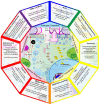Disease Resistance Mechanisms in Plants
- PMID: 29973557
- PMCID: PMC6071103
- DOI: 10.3390/genes9070339
Disease Resistance Mechanisms in Plants
Abstract
Plants have developed a complex defense system against diverse pests and pathogens. Once pathogens overcome mechanical barriers to infection, plant receptors initiate signaling pathways driving the expression of defense response genes. Plant immune systems rely on their ability to recognize enemy molecules, carry out signal transduction, and respond defensively through pathways involving many genes and their products. Pathogens actively attempt to evade and interfere with response pathways, selecting for a decentralized, multicomponent immune system. Recent advances in molecular techniques have greatly expanded our understanding of plant immunity, largely driven by potential application to agricultural systems. Here, we review the major plant immune system components, state of the art knowledge, and future direction of research on plant⁻pathogen interactions. In our review, we will discuss how the decentralization of plant immune systems have provided both increased evolutionary opportunity for pathogen resistance, as well as additional mechanisms for pathogen inhibition of such defense responses. We conclude that the rapid advances in bioinformatics and molecular biology are driving an explosion of information that will advance agricultural production and illustrate how complex molecular interactions evolve.
Keywords: coevolution; defense response; disease resistance; nucleotide-binding leucine-rich repeat; pathogenesis; pattern recognition receptor; phytopathology; plant immunity; plant-pest interaction; resistance gene.
Conflict of interest statement
The authors declare no conflict of interest.
Figures

References
-
- Whetzel H.H. An Outline of the History of Phytopathology. WB Saunders; Philadelphia, PA, USA: 1918.
-
- Moutinho-Pereira J., Magalhaes N., Torres de Castro L., Manuela Chaves M., Torres-Pereira J. Physiological responses of grapevine leaves to bordeaux mixture under light. Vitis. 2001;40:117–121.
-
- Kutschera U., Hossfeld U. Physiological phytopathology: Origin and evolution of a scientific discipline. J. Appl. Bot. Food Qual. 2012;85:1–5.
-
- Bushnell W. The Cereal Rusts: Origins, Specificity, Structure, and Physiology. Volume 1 Elsevier; Amsterdam, The Netherlands: 2012.
Publication types
LinkOut - more resources
Full Text Sources
Other Literature Sources

